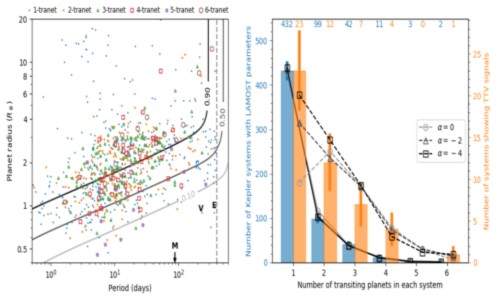Thousands of extra-solar planets have been detected with the launch of the Kepler satellite in 2009. Surprisingly, these exoplanets are not like any of the planets in our Solar system. The majority of them have sizes between Earth and Neptune and orbital periods within 100 days. Compared to such super-Earths, our Solar system planets are either too small or too far away from the host star. Does this mean our Solar system is a special case?
Studies in the past few years seemed to suggest so. These studies found that more than 50% of Sun-like stars should have at least one super-Earth. In other words, our Solar system belongs to the minority of stars that do not host super-Earths. However, all these studies rely on a single assumption: the orbital planes of multiple planets in the same system are coplanar. From our knowledge of the Solar system as well as a few compact systems found by Kepler, this assumption seems to hold, but it has not been validated for the majority of systems that only have a few (less than 3) planets.
A recent study led to Dr. Wei Zhu from the Canadian Institute for Theoretical Astrophysics (CITA) studied this issue, using data taken by the Large Sky Area Multi-Object Fiber Spectroscopic Telescope (LAMOST, also known as Guoshoujing Telescope). This study is done in collaboration with Dr. Cristobal Petrovich (CITA), Prof. Yanqin Wu (University of Toronto), Dr. Subo Dong (PKU-KIAA), and Dr. Ji-wei Xie (NJU). They found that, the coplanarity assumption no longer holds when the number of planets in the system reduces. Based on this new result, they re-evaluated the fraction of stars with super-Earths, and found that stars that do not host super-Earths, such as our Sun, are in fact the majority. This study has been published on the Astrophysical Journal on June 18th, 2018.
The most efficient in taking stellar spectra, LAMOST had finished observing and obtained precise stellar parameters for over 60,000 stars in the Kepler field. From this spectacular data set, the team found about 30,000 Sun-like stars, around 589 of which 827 transiting planets (tranets) were found by Kepler. The team classified the whole sample based on the number of tranets in the system. This is shown as the blue histogram in the Figure. They also used a so-called transit timing variation (TTV) technique. According to Kepler’s third law, a planet orbits around its host with a fixed orbital period, and thus the interval between individual transit events is an integer factor of this orbital period. When multiple planets exist in the system, however, the gravity from neighbouring planets can perturb the orbit of the tranet, causing the transit event to arrive earlier or later than the strictly periodic motion. Using this technique, one can detect additional planet in the same system, regardless of whether such planet transits or not. The team found out all the tranets showing TTV signals, and classified them based on the number of tranets in the system. The resulting histogram is shown as orange in the Figure. The team found that, these two histograms could not be reproduced if all multi-planet systems were coplanar. In order to match the data, the systems with fewer planets must be dynamically “hotter” (i.e., the planets can be largely misaligned), and the systems with more planets must be dynamically “colder” (i.e., more close to coplanar). This finding is also consistent with the previous work led by Dr. Ji-wei Xie, which is also based on LAMOST data.
Now that multi-planet systems are no longer coplanar, the resulting estimates on the fraction of stars with planets are also incorrect. Based on the updated architecture of multi-planet systems, the team concluded that only 30% of Sun-like stars host super-Earths. In other words, our Solar system belongs to the majority of stars that do not have super-Earths. Furthermore, this new study also found that each planetary system that was detected by Kepler on average has three super-Earths within orbital periods of 400 days. This “coincides” with our Solar system because there are also three (smaller) planets within the same range. Whether there is deeper meaning of this “coincidence” or not is unclear yet.
Planets tend to appear in multi-planet systems. Therefore, the correct understanding of the architecture of multi-planet system provides important clues toward the theoretical understanding of the planet formation and evolution. Large astronomical projects such as LAMOST play crucial roles in the search of exoplanets in general, as well as the second Solar system in particular.
Scientific Paper Access:http://iopscience.iop.org/article/10.3847/1538-4357/aac6d5

Left panel: The distribution of planet radii vs. Orbital periods of 827 exoplanets used in the study. The shape of the symbol represents the number of transiting planets (tranets) detected in the system. The three solid curves indicate the 90%, 50%, and 10% detection sensitivity of Kepler satellite, and the vertical dashed line indicates the longest period (400 days) that Kepler can detect. Positions of the three Solar systems planets (Mercury, Venus, Earth) are also indicated in the plot.
Right panel: Histograms based on the number of tranets in individual system and whether or not TTV effect is detected. The curves are the expectations from different models. In particular, α=0 curve is the model based on the coplanarity assumption. This curve cannot explain the data, and therefore is securely excluded.

Address: 20A Datun Road, Chaoyang District, Beijing, China code: 100012
Tel: 010-64888708 E-mail: naoc@nao.cas.cn

